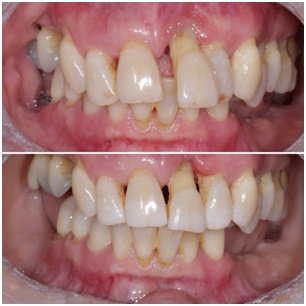Periodontal Splinting (for mobile teeth)
What is periodontal splinting?
This is a form of treatment in which mobile teeth carefully splinted together therefore reducing/eliminating mobility. However, this will not treat any gum disease (which would’ve caused the teeth to become loose in the first place). Maintaining a high level of oral hygiene is advised.
Periodontal Splinting Techniques – Treatment options for mobile/ loose teeth (or teeth becoming loose)?
- Do nothing – this is not recommended as the gum disease will likely progress leading to loss of teeth. As the teeth become more mobile, they are likely to drift therefore resulting in the change of the bite and creating spaces between the teeth and at their necks.
- See a periodontist/ dentist to stabilise the gum disease, the teeth may appear firmer and then it is up to you whether you want to pro-actively have them splinted.
- Following stabilisation of periodontal disease to have orthodontic treatment to align the teeth. In most cases this is not possible due to the teeth being compromised.
- Have the teeth extracted and replaced with a bridge. This is a suitable option if the teeth supporting the bridge have sufficient tooth structure and adequate bone support.
- Have the teeth extracted and have implants placed. Prior to having implants (which involves surgery), the patient must have the periodontal condition stabilised to reduce failure. Not all patients are suitable for implants.
- Have the teeth extracted and have dentures placed. This is a removable appliance (advised to remove at night) replacing missing teeth and soft tissues.
- Have the teeth splinted. This can be carried out using various techniques (outlined below). This is least invasive, reliable form of treatment. Unfortunately, many patients are not presented with this treatment option and have teeth extracted which could’ve potentially been delayed.
How is Periodontal Splinting Treatment carried out?
There are several methods when it comes to splinting teeth. However, many can lead to failure due to the intricate nature of the treatment and compromised condition of the teeth.
The treatment recommended by our dentist London is using EverStick Perio. This is a bundle of pre-impregnated unidirectional glass fibres allowing us to reliably splint teeth using the minimally invasive dentistry concept. This offers a long lasting, minimally invasive and a comfortable solution for periodontally compromised patients.
The aesthetic glass fibre is hidden behind the teeth and is bonded to teeth using aesthetic resin (after a shade match). This fibre splint is not visible therefore providing excellent aesthetics. This is a very technique sensitive procedure which can allow us to carefully reposition mobile teeth (close any spaces that may have recently opened) and splint them together. By splinting the teeth, the adjacent teeth are used for anchorage creating one solid unit and reducing/eliminated any mobility. Furthermore, a bonus is if the tooth does require extraction in the future, the root can be sectioned off (amputated) leaving the patients natural crown in the splint (aesthetically the most natural bridge as the patient’s own tooth is used).
The steps are highlighted below:

This can be completed in under an hour.
Dr. Krishen Shah who is always looking at ways to increase patient comfort, has extensive experience splinting periodontally compromised teeth with Everstick Perio.
Periodontal Splinting Techniques – Case Examples
Periodontal Splinting Techniques – Case 1:
Having splinted the lower arch in 2016, the patient returned wanting the upper arch to be splinted in 2017, as gaps started to appear between his front teeth (as one was becoming very loose)
Before:

After:
There is a reduction in the gap between the front two teeth.

Periodontal Splinting Techniques – Case 2:
Unfortunately, due to ill health, this patient’s teeth have really suffered in the last few years. This patient had a loose front tooth which she was resigned to losing. She wanted to delay having a bridge/denture and wanted to avoid invasive treatment (implants).
Several other front teeth were also mobile and this patient opted for a glass fibre reinforced splint (having presented all options), with the possibility of amputating the really loose tooth in the future leaving the crown of the tooth acting as a natural bridge.
This was a difficult case to splint due the severe mobility, the teeth were also re-contoured and the patient opted not to have the black triangles concealed as she was already ecstatic with the results.


Periodontal Splinting Cost
At Smile Cliniq, periodontal splinting costs start, on average, from £350 but it is a very personalised treatment and the cost will vary depending on the complexity of treatment.
Periodontal Splinting FAQs
Are there any alternative treatments to periodontal splinting techniques?
Often orthodontic treatment is seen as an alternative as it helps reposition teeth so received forces are evenly spread out. However, periodontal splinting techniques are complicated – especially if there is underlying periodontal disease. If there is disease, it must be controlled before to ensure the success of orthodontic treatment. Indeed, periodontitis disease comes with progressive tooth loss if it isn’t adequately managed.
How long must you wear a periodontal splint for?
Many patients have concerns over the duration for which they will need to wear a periodontal splint. It depends on your individual case as the severity of your loosened teeth will provide you with insight on how long to expect to wear a periodontal splint. If your tooth as loosened severely because of trauma, then a periodontal splint will be used to stabilise your teeth while they heal.
In most cases, it is common to wear a periodontal splint for 14-days but sometimes could be longer. It’s important to consider the long-term outlook of your teeth before you decide on the best treatment option. While temporary periodontal splinting can be a good short-term solution, when tooth damage is very severe, the teeth themselves may need replacing. Therefore, we advise to get in touch with our specialist team to discuss the best option for you.
What happens is periodontal splinting doesn’t work?
In the case where your tooth has been knocked out completely, periodontal splinting techniques can help it heal back in place if you got to the dentist quickly. But if it doesn’t work, reconstructive dentistry has many other approaches to repair your smile.
If your tooth heals back in place, but the pulp dies, often resulting in discoloration of the tooth (also known as dark tooth), a root canal is used to make sure the tooth doesn’t become infected.
If the tooth doesn’t heal back in place, we can use a dental implant to replace the tooth. Sometimes, the tooth may seem to heal, but it can experience problems months or years later, such as resorption (removal) of the tooth root. We can treat these problems as they arise.
- Please click here for our fees guide.
- Please click here for examples of our work
- For further details of our techniques, materials and techniques please click here.
- Please click here for our guide to maintaining your oral hygiene.
- Interest free payment options are available
- Return to the top of the page










Finchley
020 3582 8621
St Johns Wood
020 3627 8732
Smile Cliniq Limited. A company registered in England and Wales. Company number 08279068.
Registered office: C/O TG Associates 7 Jardine House, Harrovian Business Village, Bessborough Road, Harrow, Middlesex, HA1 3EX
Terms of Use | Privacy Policy | Health & Safety Charter | Complaints procedure | Data Protection | Cookie Settings
Website by Digimax Dental









